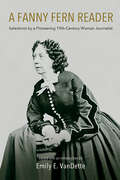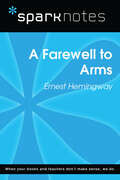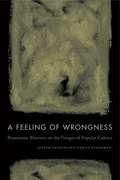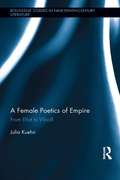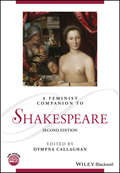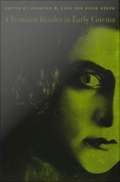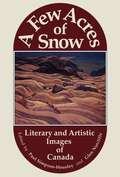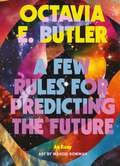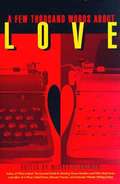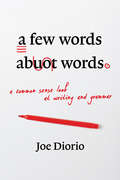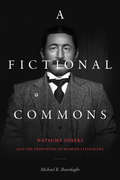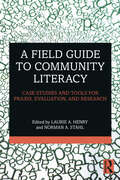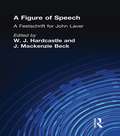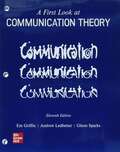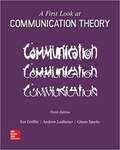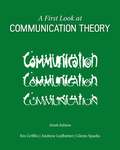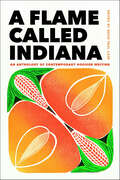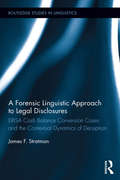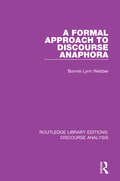- Table View
- List View
A Fanny Fern Reader: Selections by a Pioneering Nineteenth-Century Woman Journalist
by Fanny FernIn the middle of the nineteenth century, the highest paid and most famous newspaper writer in the US was a woman known to the world as Fanny Fern, the nom de plume of Sara Payson Willis. A Fanny Fern Reader features a selection of Fern's columns, mostly from her years as a weekly columnist for the New York Ledger, along with an introduction that shares the remarkable story of Fern's perseverance and success as a woman in a male-dominated profession. For readers in her own time, Fern's frank and unbridled social commentary and boldly satirical voice made her a household name. Fern's subversive and witty commentary about social mores, gender roles, childhood, authorship, and family life transcend time and continue to resonate with and entertain readers today. A Fanny Fern Reader is the most extensive collection of Fern's newspaper writings to date and includes several works that have been out of print for over a century, making this author's writing on a wide range of issues accessible for readers within and outside of classrooms and academic settings.
A Farewell to Arms (SparkNotes Literature Guide Series)
by SparkNotesA Farewell to Arms (SparkNotes Literature Guide) by Ernest Hemingway Making the reading experience fun! Created by Harvard students for students everywhere, SparkNotes is a new breed of study guide: smarter, better, faster.Geared to what today's students need to know, SparkNotes provides:chapter-by-chapter analysis explanations of key themes, motifs, and symbols a review quiz and essay topics Lively and accessible, these guides are perfect for late-night studying and writing papers.
A Feeling for Books
by Janice A. RadwayDeftly melding ethnography, cultural history, literary criticism, and autobiographical reflection, A Feeling for Books is at once an engaging study of the Book-of-the-Month Club's influential role as a cultural institution and a profoundly personal meditation about the experience of reading. Janice Radway traces the history of the famous mail-order book club from its controversial founding in 1926 through its evolution into an enterprise uniquely successful in blending commerce and culture. Framing her historical narrative with writing of a more personal sort, Radway reflects on the contemporary role of the Book-of-the-Month Club in American cultural history and in her own life. Her detailed account of the standards and practices employed by the club's in-house editors is also an absorbing story of her interactions with those editors. Examining her experiences as a fourteen-year-old reader of the club's selections and, later, as a professor of literature, she offers a series of rigorously analytical yet deeply personal readings of such beloved novels as Marjorie Morningstar and To Kill a Mockingbird. Rich and rewarding, this book will captivate and delight anyone who is interested in the history of books and in the personal and transformative experience of reading.
A Feeling of Wrongness: Pessimistic Rhetoric on the Fringes of Popular Culture
by Joseph Packer Ethan StonemanIn A Feeling of Wrongness, Joseph Packer and Ethan Stoneman confront the rhetorical challenge inherent in the concept of pessimism by analyzing how it is represented in an eclectic range of texts on the fringes of popular culture, from adult animated cartoons to speculative fiction.Packer and Stoneman explore how narratives such as True Detective, Rick and Morty, Final Fantasy VII, Lovecraftian weird fiction, and the pop ideology of transhumanism are better suited to communicate pessimistic affect to their fans than most carefully argued philosophical treatises and polemics. They show how these popular nondiscursive texts successfully circumvent the typical defenses against pessimism identified by Peter Wessel Zapffe as distraction, isolation, anchoring, and sublimation. They twist genres, upend common tropes, and disturb conventional narrative structures in a way that catches their audience off guard, resulting in belief without cognition, a more rhetorically effective form of pessimism than philosophical pessimism.While philosophers and polemicists argue for pessimism in accord with the inherently optimistic structures of expressive thought or rhetoric, Packer and Stoneman show how popular texts are able to communicate their pessimism in ways that are paradoxically freed from the restrictive tools of optimism. A Feeling of Wrongness thus presents uncharted rhetorical possibilities for narrative, making visible the rhetorical efficacy of alternate ways and means of persuasion.
A Feeling of Wrongness: Pessimistic Rhetoric on the Fringes of Popular Culture
by Joseph Packer Ethan StonemanIn A Feeling of Wrongness, Joseph Packer and Ethan Stoneman confront the rhetorical challenge inherent in the concept of pessimism by analyzing how it is represented in an eclectic range of texts on the fringes of popular culture, from adult animated cartoons to speculative fiction.Packer and Stoneman explore how narratives such as True Detective, Rick and Morty, Final Fantasy VII, Lovecraftian weird fiction, and the pop ideology of transhumanism are better suited to communicate pessimistic affect to their fans than most carefully argued philosophical treatises and polemics. They show how these popular nondiscursive texts successfully circumvent the typical defenses against pessimism identified by Peter Wessel Zapffe as distraction, isolation, anchoring, and sublimation. They twist genres, upend common tropes, and disturb conventional narrative structures in a way that catches their audience off guard, resulting in belief without cognition, a more rhetorically effective form of pessimism than philosophical pessimism.While philosophers and polemicists argue for pessimism in accord with the inherently optimistic structures of expressive thought or rhetoric, Packer and Stoneman show how popular texts are able to communicate their pessimism in ways that are paradoxically freed from the restrictive tools of optimism. A Feeling of Wrongness thus presents uncharted rhetorical possibilities for narrative, making visible the rhetorical efficacy of alternate ways and means of persuasion.
A Female Poetics of Empire: From Eliot to Woolf (Routledge Studies in Nineteenth Century Literature)
by Julia KuehnMany well-known male writers produced fictions about colonial spaces and discussed the advantages of realism over romance, and vice versa, in the ‘art of fiction’ debate of the 1880s; but how did female writers contribute to colonial fiction? This volume links fictional, non-fictional and pictorial representations of a colonial otherness with the late nineteenth-century artistic concerns about representational conventions and possibilities. The author explores these texts and images through the postcolonial framework of ‘exoticism’, arguing that the epistemological dilemma of a ‘self’ encountering an ‘other’ results in the interrelated predicament to find poetic modalities – mimetic, realistic and documentary on the one hand; romantic, fantastic and picturesque on the other – that befit an ‘exotic’ representation. Thus women writers did not only participate in the making of colonial fictions but also in the late nineteenth-century artistic debate about the nature of fiction. This book maps the epistemological concerns of exoticism and of difference – self and other, home and away, familiarity and strangeness – onto the representational modes of realism and romance. The author focuses exclusively on female novelists, travel writers and painters of the turn-of-the-century exotic, and especially on neglected authors of academically under-researched genres such as the bestselling novel and the travelogue.
A Feminist Companion to Shakespeare
by Dympna CallaghanThe question is not whether Shakespeare studies needs feminism, but whether feminism needs Shakespeare. This is the explicitly political approach taken in the dynamic and newly updated edition of A Feminist Companion to Shakespeare. Provides the definitive feminist statement on Shakespeare for the 21st century Updates address some of the newest theatrical andcreative engagements with Shakespeare, offering fresh insights into Shakespeare's plays and poems, and gender dynamics in early modern England Contributors come from across the feminist generations and from various stages in their careers to address what is new in the field in terms of historical and textual discovery Explores issues vital to feminist inquiry, including race, sexuality, the body, queer politics, social economies, religion, and capitalism In addition to highlighting changes, it draws attention to the strong continuities of scholarship in this field over the course of the history of feminist criticism of Shakespeare The previous edition was a recipient of a Choice Outstanding Academic Title award; this second edition maintains its coverage and range, and bringsthe scholarship right up to the present day
A Feminist Reader in Early Cinema
by Jennifer M. Bean Diane NegraA Feminist Reader in Early Cinema marks a new era of feminist film scholarship. The twenty essays collected here demonstrate how feminist historiographies at once alter and enrich ongoing debates over visuality and identification, authorship, stardom, and nationalist ideologies in cinema and media studies. Drawing extensively on archival research, the collection yields startling accounts of women's multiple roles as early producers, directors, writers, stars, and viewers. It also engages urgent questions about cinema's capacity for presenting a stable visual field, often at the expense of racially, sexually, or class-marked bodies. While fostering new ways of thinking about film history, A Feminist Reader in Early Cinema illuminates the many questions that the concept of "early cinema" itself raises about the relation of gender to modernism, representation, and technologies of the body. The contributors bring a number of disciplinary frameworks to bear, including not only film studies but also postcolonial studies, dance scholarship, literary analysis, philosophies of the body, and theories regarding modernism and postmodernism. Reflecting the stimulating diversity of early cinematic styles, technologies, and narrative forms, essays address a range of topics--from the dangerous sexuality of the urban flneuse to the childlike femininity exemplified by Mary Pickford, from the Shanghai film industry to Italian diva films--looking along the way at birth-control sensation films, French crime serials, "war actualities," and the stylistic influence of art deco. Recurring throughout the volume is the protean figure of the New Woman, alternately garbed as childish tomboy, athletic star, enigmatic vamp, languid diva, working girl, kinetic flapper, and primitive exotic. Contributors. Constance Balides, Jennifer M. Bean, Kristine Butler, Mary Ann Doane, Lucy Fischer, Jane Gaines, Amelie Hastie, Sumiko Higashi, Lori Landay, Anne Morey, Diane Negra, Catherine Russell, Siobhan B. Somerville, Shelley Stamp, Gaylyn Studlar, Angela Dalle Vacche, Radha Vatsal, Kristen Whissel, Patricia White, Zhang Zhen
A Few Acres of Snow: Literary and Artistic Images of Canada
by Paul Simpson-Housley Glen NorcliffeIn 1759, Voltaire in Candide referred to Canada as "quelques arpents de neige." For several centuries, the image prevailed and was the one most frequently used by poets, writers, and illustrators. Canada was perceived and portrayed as a cold, hard, and unforgiving land. this was not a land for the fainthearted. Canada has yieled its wealth only reluctantly, while periodically threatening life itself with its displays of fury. Discovering its beauty and hidden resources requires patience and perseverance. A Few Acres of Snow is a colletion of twenty-two essays that explore, from the geographer’s perspective, how poets, artists, and writers have addressed the physical essence of Canada, both landscape and cityscape. "Sense of place" is clearly critical in the works examined in this volume. Included among the book’s many subjects are Hugh MacLennan, Gabrielle Roy, Lucius O’Brien, the art of the Inuit, Lawren Harris, Malcolm Lowry, C.W. Jefferys, L.M. Montgomery, Elizabeth Bishop, Marmaduke Matthews, Antonine Mailet, and the poetry of Japanese Canadians.
A Few Rules for Predicting the Future
by Octavia E. Butler'There's no single answer that will solve all our future problems.There's no magic bullet.Instead there are thousands of answers - at least.You can be one of them if you choose to be'***Honest and wise advice from legendary writer and Afrofuturist pioneer, Octavia E. Butler - for anyone who wants to shape our future into something good.A little book to give or to keep, with stunning new artwork by Manzel Bowman.Based on an essay written in 2000. As timely and prescient today as it was then.
A Few Thousand Words about Love
by Mickey PearlmanMickey Pearlman invited established writers and rising stars to think about that eternally evocative subject. The answer that emerged from these gifted writers is a collection of original memoirs about: a Broadway songwriting grandmother, the adoption of a biracial daughter, the love of a gay man for his aging grandmother, a Chinese father's love letters to the writer's mother, a traumatic but transformative childbirth experience, a love affair with one's wife in Paris, and the familiar sibling rivalry between a toddler and her newborn sister. Like fresh rain falling on time-worn Parisian streets, the writers--Peter Cameron, Ron Carlson, Angela Davis-Gardner, Tim Gautreaux, Myra Goldberg, Brian Hall, Linda Hogan, Caroline Leavitt, Margot Livesey, Elizabeth McCracken, Dennis McFarland, Joyce Carol Oates, Larry O'Connor, Mickey Pearlman, Carolyn See, Katharine Weber, and Shawn Wong--play a contemporary riff on an age-old song.
A Few Words About Words
by Joseph J. DiorioHONORED AS A NOTABLE 100 BOOK IN THE 2021 SHELF UNBOUND BEST INDIE BOOK COMPETITIONFINALIST FOR THE 2021 FOREWORD INDIES AWARDSPenned by a writer who had to teach himself the rules of English grammar, A Few Words About Words offers an easy and accessible approach to understanding and using the English language.In a world dominated by countless print and social media outlets, written communication is king. Writing "your" when you mean "you're" and "there" when you mean "they're" can make the difference between getting or not getting new business. A missing comma can result in a PR catastrophe, and a well-written line can be remembered for generations. And yet, many native speakers struggle with the English language.Spawned from the widely-circulated and beloved newsletter of the same name, Joe Diorio's A Few Words About Words blends quick-witted anecdotes from more than 30 years of newsletter entries that highlight the common, uncommon, and surprising grammar mistakes most English speakers make. The result is a digestible, all-encompassing look at English grammar.Humorous, enlightening, and completely comprehensible, A Few Words About Words will be the go-to grammar guide you pick up and can't put down.
A Fictional Commons: Natsume Soseki and the Properties of Modern Literature
by Michael K. BourdaghsModernity arrived in Japan, as elsewhere, through new forms of ownership. In A Fictional Commons, Michael K. Bourdaghs explores how the literary and theoretical works of Natsume Sōseki (1867–1916), widely celebrated as Japan's greatest modern novelist, exploited the contradictions and ambiguities that haunted this new system. Many of his works feature narratives about inheritance, thievery, and the struggle to obtain or preserve material wealth while also imagining alternative ways of owning and sharing. For Sōseki, literature was a means for thinking through—and beyond—private property. Bourdaghs puts Sōseki into dialogue with thinkers from his own era (including William James and Mizuno Rentarō, author of Japan’s first copyright law) and discusses how his work anticipates such theorists as Karatani Kōjin and Franco Moretti. As Bourdaghs shows, Sōseki both appropriated and rejected concepts of ownership and subjectivity in ways that theorized literature as a critical response to the emergence of global capitalism.
A Field Guide to Community Literacy: Case Studies and Tools for Praxis, Evaluation, and Research
by Laurie A. Henry Norman A. StahlThis practical guidebook presents trends, research-grounded strategies, and field-based solutions to challenges of working in community-based literacy initiatives. A comprehensive guide for practitioners, this book addresses best practices for implementing, maintaining, expanding, and evaluating community-based literacy initiatives. The contributors in this volume help readers shift thinking from merely considering, "How can communities support literacy?" to "How can literacy help us create, support, and strengthen communities?" Organized into four parts – on building community through literacy, program design, case studies from the field, and program evaluation – chapters cover research-based and innovative practices in a diverse range of populations and settings, including family services, adult literacy initiatives, community centers, and tutoring programs. With an abundance of praxis-oriented examples and real-world strategies from top scholars and practitioners, the book serves as a roadmap for essential topics, including funding, writing grant proposals, handling audits, and conducting research within program settings. With templates, models, planning tools, and checklists ready for immediate use, this book is an invaluable field manual for individuals involved in community literacy work, researchers, and students in literacy-oriented courses either at the undergraduate or graduate levels.
A Field Guide to Narnia
by Colin DuriezFrom the Book jacket: Whether this is your first visit or you've been there many times, you'll want to bring along this handy guide to the landscape and inhabitants of Narnia. You'll learn more about the mind behind Narnia, how Narnia relates to other imaginative worlds and children's literature, the history within the stories of Narnia, and how Narnia fits into Lewis's other work. This book will help you dig deeper into the series and its implications for understanding the Christian life. "Colin Duriez . . . provides profound insight into the brilliant mind and prolific writings of C. S. Lewis. By carefully interweaving the life experiences of Lewis with an analysis of his vast body of scholarly and popular works-especially his Chronicles of Narnia- Mr. Duriez provides the reader with new understanding and a strong motivation to read the works again and again."
A Figure of Speech: A Festschrift for John Laver
by W. J. Hardcastle J. Mackenzie BeckThroughout the world, there are phoneticians who have been influenced by the teaching, research, and writings of John Laver. Many have worked with him personally, and most of the contributors to this book are people with whom he has had special links or whose involvement represents an appreciation of the breadth of Laver's interests. While the book is meant to be a tribute to John Laver, the topics have been chosen to provide an overview of some key issues in phonetics, with illuminating contributions from some of the most influential academics in the field. Contributing to this festschrift are William Hardcastle, Janet Mackenzie Beck, Peter Ladefoged, John J. Ohala, F. Gibbon, Anne Cutler, Mirjam Broersma, Helen Fraser, Peter F. MacNeilage, Barbara L. Davis, R. E. Asher, E. L. Keane, G. J. Docherty, P. Foulkes, Janet Fletcher, Catherine Watson, John Local, Ailbhe Ní Chasaide, Christer Gobl, John H. Esling, Jimmy G. Harris, and Francis Nolan.
A Fine Coat (Book 6)
by Barbara W. MakarDecodable Storybooks 2A accompany More Workbook 2 and provide additional opportunity to apply the phonetic concepts introduced in Workbook 2 to connected text. The storybooks use the same vocabulary as Workbook 2 and Storybooks 2 with the addition of one sight word was. Storybooks 2A are an excellent tool to reinforce the skills from Workbook 2 and can be used with either Workbook 2 or More Workbook 2"--Epsbooks.com.
A First Look At Communication Theory
by Andrew Ledbetter Emory A. Griffin Glenn Grayson SparksThe 11th edition of A First Look at Communication Theory encourages students who are encountering the field for the first time to tackle theories without fear. The authors’ conversational style and relevant examples keep complex theories within the grasp of first-time theory students. They introduce over 30 diverse theories that are a mix of foundational and recent scholarship and, with the benefit of numerous examples and connections to pop culture, help students apply them to their own lives. The discrete presentation of the theories ensures a well-rounded understanding of each while promoting integrative thinking and facilitating the ability of instructors to skip or rearrange their presentation. The broad selection of theories-from the classics to the cutting edge-ensures that students have a solid foundation with which to begin understanding the relationships between theories.
A First Look at Communication Theory
by Glenn Sparks Em Griffin Andrew LedbetterThe tenth edition of A First Look at Communication Theory justifies again the program's enduring popularity. EM Griffin, now joined by colleagues Andrew Ledbetter and Glenn Sparks, encourages students who are encountering the field for the first time to tackle theories without fear. <p><p> The text's conversational style and relevant examples keep complex theories within the grasp of first-time theory students. The authors introduce 32 diverse theories that are a mix of foundational and recent scholarship and, with the benefit of numerous examples and connections to pop culture, help students apply them to their own lives. The discrete presentation of the theories ensures a well-rounded understanding of each while promoting integrative thinking and facilitating the ability of instructors to skip or rearrange their presentation. <p><p> The broad selection of theories-from the classics to the cutting edge-ensures that students have a solid foundation with which to begin understanding the relationships between theories.
A First Look at Communication Theory (Ninth Edition)
by Glenn Sparks Em Griffin Andrew LedbetterThe ninth edition of A First Look at Communication Theory justifies again the program's enduring popularity. Em Griffin, now joined by colleagues Andrew Ledbetter and Glenn Sparks, encourages students who are encountering the field for the first time to tackle theories without fear. The authors introduce 32 diverse theories that are a mix of foundational and recent scholarship and, with the benefit of numerous examples and connections to pop culture, help students apply them to their own lives. This program ensures that students have a solid foundation with which to begin understanding the relationships between theories.
A Flame Called Indiana: An Anthology of Contemporary Hoosier Writing
by Doug Paul CaseAs Kurt Vonnegut, Indiana's most famous writer, once remarked, "Wherever you go, there is always a Hoosier doing something important there."A Flame Called Indiana features 65 writers of fiction, nonfiction, and poetry who have all had the pleasure of being Hoosiers at one time or another. Curated by the Indiana University Bloomington creative writing department, this diverse anthology features everything from the immigrant experience to the Indianapolis 500 to science fiction. Altogether, the work stands testament to the vibrancy and creativity of this Midwest state.An excellent gift for your favorite reader and an important resource for creative writers, A Flame Called Indiana serves as both a chronicle of where Indiana's writing is today and a beacon to those who'll take it where it's going next.
A Floating Chinaman: Fantasy and Failure across the Pacific
by Hua HsuWho gets to speak for China? During the interwar years, when American condescension toward China yielded to fascination with all things Chinese, a circle of writers sparked an unprecedented conversation over U.S.-Chinese relations. Hua Hsu tells how they became ensnared in bitter rivalries over who could claim the title of leading China expert.
A Forensic Linguistic Approach to Legal Disclosures: ERISA Cash Balance Conversion Cases and the Contextual Dynamics of Deception (Routledge Studies in Linguistics)
by James StratmanThis book is a scholarly work of forensic linguistics that demonstrates how the principles of Gricean pragmatics and their recent elaboration in Information Manipulation Theory (IMT) can be of use to courts faced with deciding cases of allegedly fraudulent disclosure documents. The usual goal of legal rules for disclosure documents is not merely to prevent lying but other forms of deception as well. In particular, the goal of these rules is to force the communicator to reveal information that could cause material harm to certain receivers, harms that the communicator, for various reasons of self-interest, might prefer to keep secret or hidden. Because IMT and the Gricean framework have seldom been used in published studies to investigate legally mandated disclosure documents aimed at laypersons, this book seeks to enrich current explications of the rhetorical "workings" of deceptive disclosures within the broader Gricean tradition of pragmatics. The book questions the fundamental relationships among Grice’s maxims as well as the much circulated notion that violation of some maxims is more deceptive and more immoral than violations of others. In addition, the book also attempts to show how various other theories and research in discourse linguistics and reading comprehension can be used to support IMT analyses in addressing the discourse processing issues unique to legally required disclosure texts. In this way the book contributes to the larger dual mission of the field of forensic linguistics, which is both to understand and to improve courts’ impact on social justice.
A Formal Approach to Discourse Anaphora (RLE: Discourse Analysis)
by Bonnie Lynn WebberFirst published in 1979, this book starts from the perspective that dealing with anaphoric language can be decomposed into two complementary tasks: 1. identifying what a text potentially makes available for anaphoric reference and 2. constraining the candidate set of a given anaphoric expression down to one possible choice. The author argues there is an intimate connection between formal sentential analysis and the synthesis of an appropriate conceptual model of the discourse. Some of the issues with the creation of this conceptual model are discussed in the second chapter, which follows a background to the thesis that catalogues the types of anaphoric expression available in English and lists the types of things that can be referred to anaphorically. The third and fourth chapters examine two types of anaphoric expression that do not refer to non-linguistic entities. The final chapter details three areas into which this research could potentially be extended. This book will be of interest to students of linguistics.
